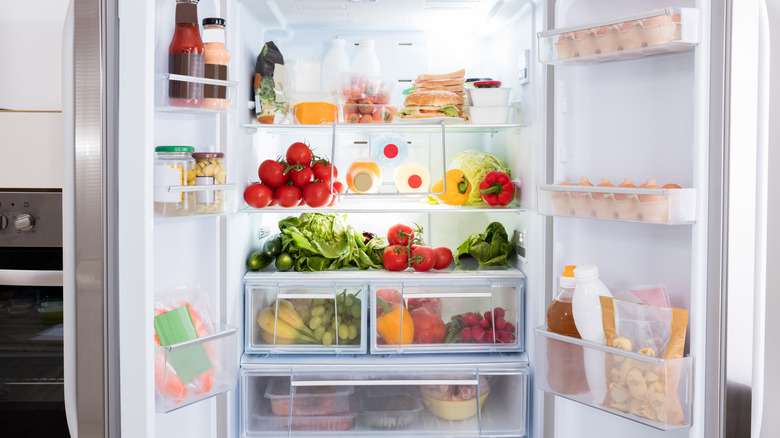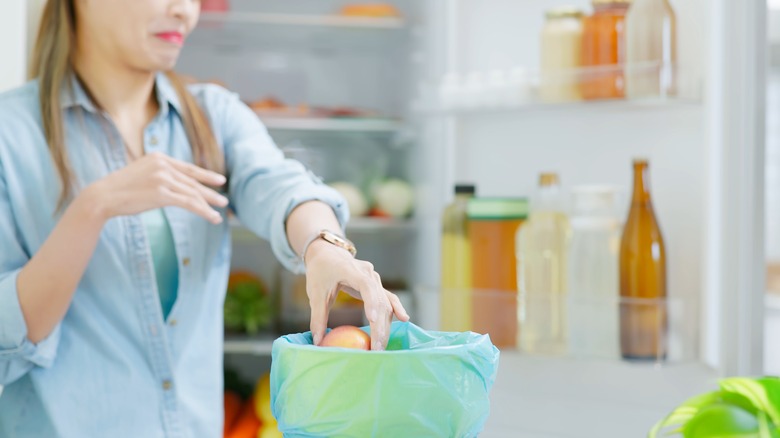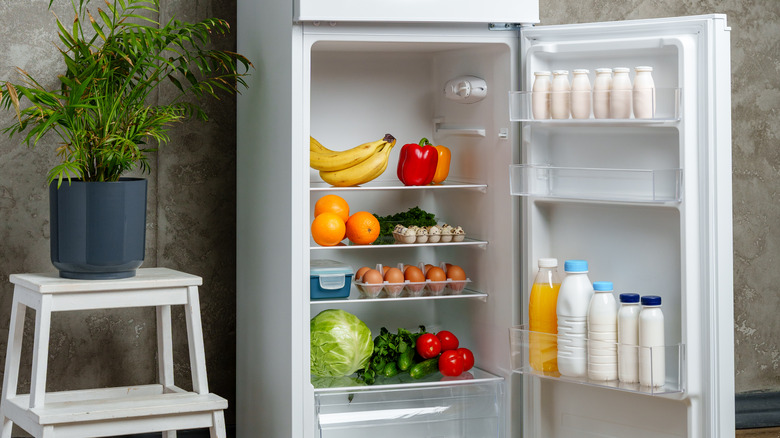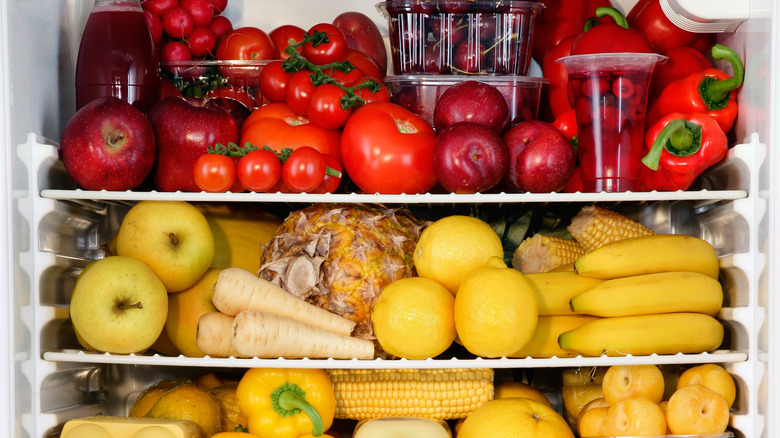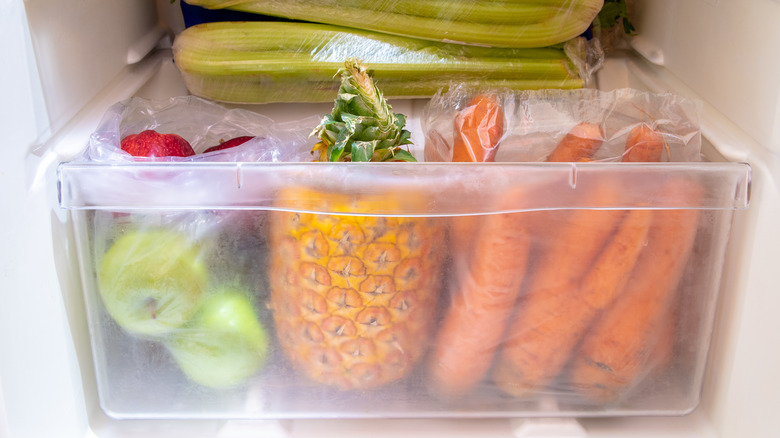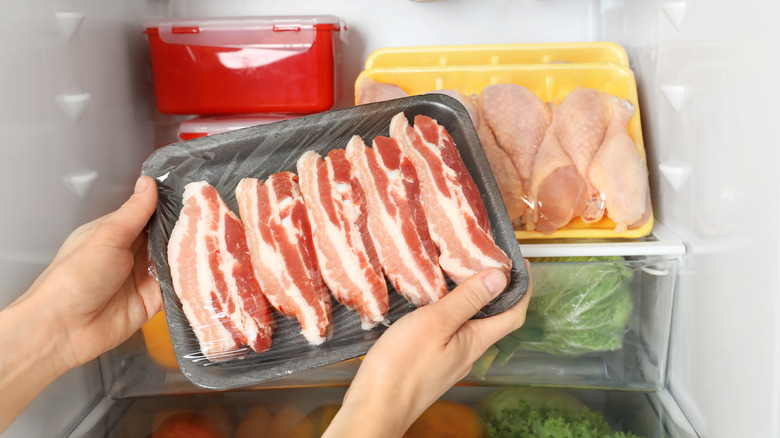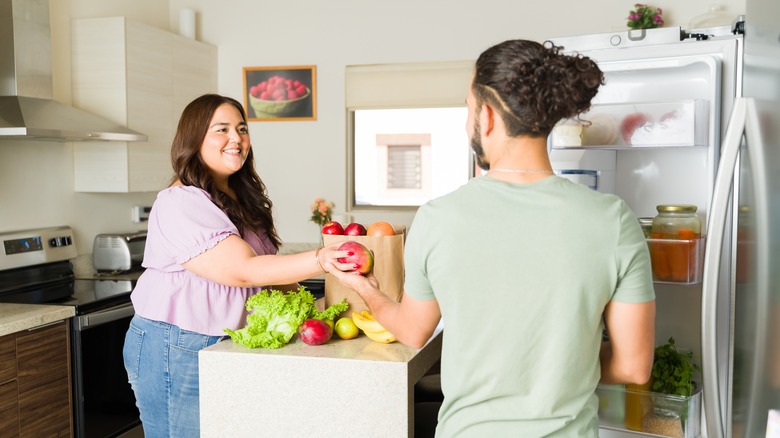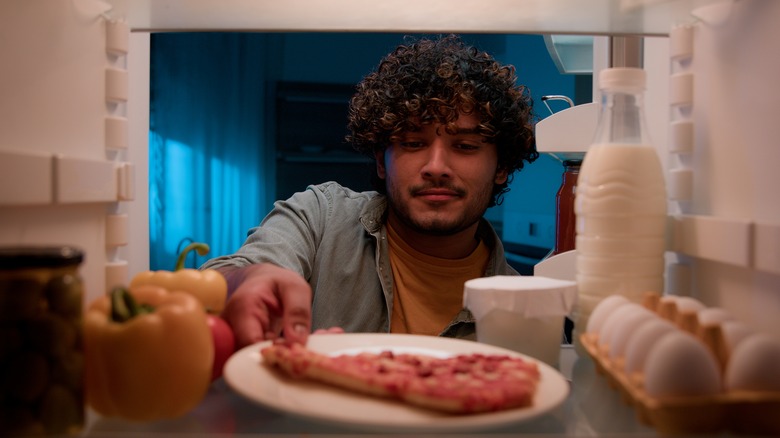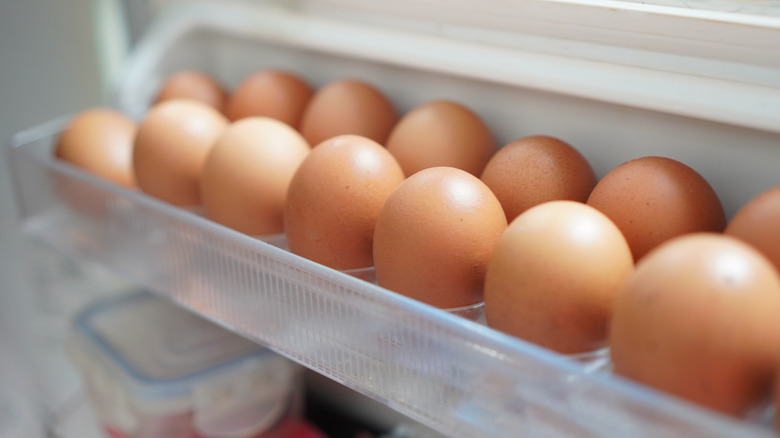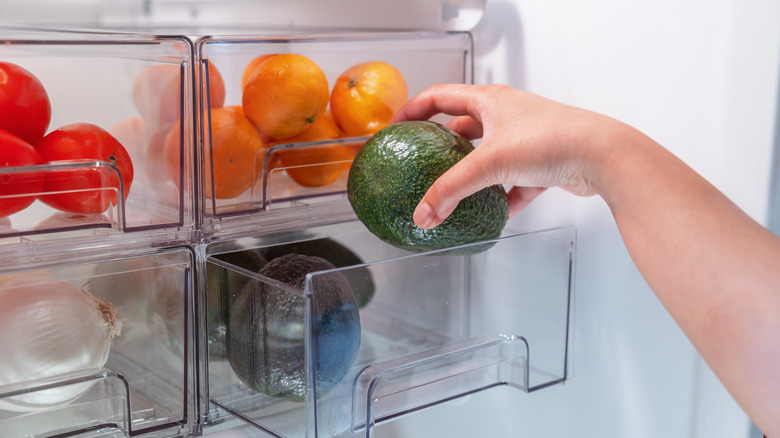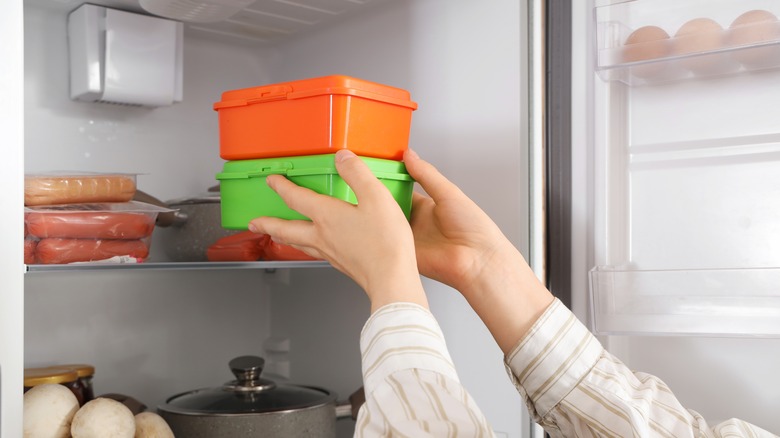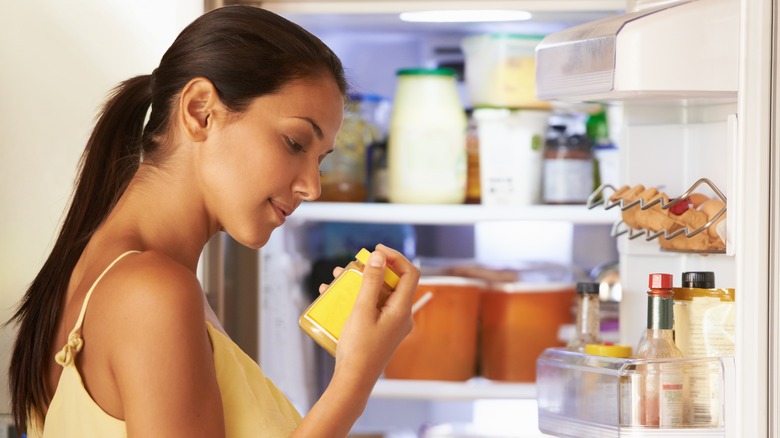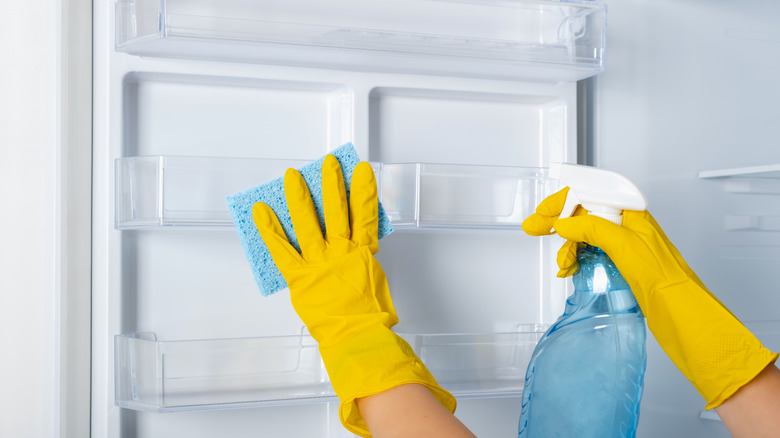Mistakes Everyone Makes With Their Fridge
Coming home from the grocery store and simply tossing food into the fridge with no rhyme or reason is a pretty common occurrence. After all, how many of us have ever gotten a tutorial on how to load a fridge properly? Not many, likely. All things considered, it may not be too surprising to learn there's a good chance you're stocking your fridge wrong. Plus, there are simple fridge upkeep tasks often overlooked. As it turns out, there's actually a wrong and right way to use your fridge — and many of us are making mistakes without even realizing it.
From storing dairy in the door to not cleaning frequently enough to keeping highly perishable items in the rear, only you know which mishaps you fall prey to. That's okay, though. After reading through the following mistakes everyone makes with their fridge (and how to avoid them), you can quickly change any bad habits and start loading and using your fridge to the best of its ability. Heck, you may even be inspired to reorganize your fridge's contents as soon as you get to the end of this article.
Tucking perishable items in the back where they are out of sight
Storing perishable items in the rear of your fridge doesn't necessarily lead to anything bad happening, but it can definitely result in unwanted food waste. Why? Well, when you keep foods like fresh produce, dairy, and leftovers out of sight, the chance of them going bad before you use them only increases. I mean out of sight, out of mind, right? That's why it is best to store the most perishable foods upfront where there is no chance of them being overlooked. Then, it is up to you to eat them before they go bad, no excuses.
Fortunately, there are plenty of recipes that can help you use up the leftovers in your fridge. Eggs for one can go into countless dishes — breakfast, lunch, or dinner. You can also put any type of veggies, cheese, or meat into a quesadilla. The possibilities are limitless, so there's no need to let food go bad before using it, especially if you don't put it in the back where it isn't easily seen.
Storing dairy in the door
Okay, so you probably don't want to store small dairy items like cheese and yogurt in the back of your fridge where it is not visible, but what about the door? Welp, turns out that isn't a great place for dairy either. While the door may seem like a convenient, grab-and-go solution, it has the least stable temperature. If you think about it, this makes perfect sense. Every time you open and close the door on your fridge the temperature fluctuates, particularly in the door since it is farthest away from the interior when open. With this in mind, choosing to keep highly perishable dairy items in the fridge isn't your best bet if you want to keep them fresh for as long as possible. Which you do. In fact, the door is the worst place to store cheese and the one place you don't want to store milk.
The best place to put milk in your fridge is in the back on one of the shelves because that is where it is the coldest. I know, perishable items in the rear are supposed to be a big no-no, but thanks to milk cartons being tall, they shouldn't lose their visibility. As for cheese, one of your fridge's crisper drawers could be its new home, as long as you have space. If not, keep it on one of the shelves, but toward the front so it doesn't get too cold and become dry.
Packing too much food inside your fridge
Overcrowding your fridge is another common mistake people make. It may be tempting to stock up on some frequently eaten items, especially if they go on sale, but only do this if you have enough room to store them. I'm not talking about squeezing them into any available space either. When food is packed tightly inside your fridge, it prevents proper air circulation, leading to uneven temperatures and possibly even hot spots. Which, as you can imagine, isn't good for foods that need to be kept at a cooler temperature — you know, anything that goes in the fridge.
Considering you want your food to stay as fresh as possible for as long as possible, giving your fridge's cool air a chance to circulate properly is ideal. Lucky us, this is actually pretty simple and straightforward. Just don't stack various items super high and cram food into every available inch of space and you should be good to go. And because overcrowding items is also a good way to forget what you have in your fridge, leaving enough room for your food items to "breathe" has multiple benefits. Don't make the mistake of overcrowding your fridge.
Keeping fruits and veggies in the same crisper bin
Storing fruits and veggies in the same crisper bin, or even right next to each other on a shelf is not ideal. It may seem harmless. However, thanks to many types of produce emitting ethylene gas — something that speeds up ripening and spoilage – it can be a bad choice. If you are trying to ripen an avocado quickly, putting it next to a banana can help, but most of the time you're not trying to speed up ripening and spoilage. For the most part, you want your produce to stay fresh for as long as possible and if you accidentally store an ethylene-producing fruit or veggie next to one that is sensitive to the gas, it could go bad before you get a chance to enjoy it.
While keeping your fruits and veggies side by side won't always cause a negative reaction, there are enough ethylene sensitive and ethylene-producing foods for you to simply keep them separated. The list of ethylene producers includes apples, avocados, bananas, cantaloupe, kiwi, peaches, pears, peppers, and tomatoes. Who can even keep track of that many ethylene producers? Plus, the list of ethylene sensitive fruits and veggies is even longer. So maybe just keeping them separated as a rule of thumb is best, not to mention easiest.
Storing meat on the upper shelves
As a fairly perishable food, it may seem like keeping your meat on the top shelf where it can be seen the moment you open your fridge is a good idea. In reality, keeping your meat, seafood, and poultry on the upper levels of your fridge could actually be a health hazard. If your meat packaging accidentally tears or the liquid from inside leaks out for any reason, it can spread and drip, resulting in the cross-contamination of other cooked and raw foods. According to the U.S. Food & Drug Administration, the liquid inside the packaging could contain harmful bacteria and if you eat something that comes in contact with it, it has the potential to make you sick. If you've ever heard the term food-borne illness, this is it. No thanks.
In an effort to keep all your food safe and raw meat, poultry, and fish properly cooled, always keep it on the lowest shelf in your fridge. Not only is it colder down there, but any potential leaks won't drip onto lower shelves, effectively spoiling everything in its path. In addition, you can also put raw meat packages into another container like a glass or plastic dish or a plastic bag to keep raw meat juices from contaminating other food.
Not keeping your fridge cold enough or always keeping it at the same temperature
When your fridge isn't cold enough, your food will suffer. If it is too cold, it could freeze items which is also bad. So, what is the ideal temperature to prevent accidental freezing but still promote freshness? Well, according to the U.S. Food & Drug Administration, your fridge should be kept at or below 40 degrees Fahrenheit. If that's too vague for you, the Department of Energy recommends a fridge temperature between 35 and 38 degrees Fahrenheit. They also note that 37 degrees Fahrenheit is ideal.
Considering how small the range for ideal fridge temperatures is, you may need to adjust the thermostat setting on your fridge from time to time. After all, they aren't always precise. I don't know about you, but mine is a wheel with numbers one through five. So, not very precise at all. As such, you may want to experiment with small changes when you pack in new groceries warm from the car, or, when there isn't a lot of food inside. You can also buy a small fridge thermometer, kind of like the ones you use in the oven if you want to get the temperature just right.
Stocking food without rotating older items up front
As if there weren't enough mistakes you can make when it comes to storing food in your fridge, here's another one. An easy misstep is to simply put all your new groceries at the front of your fridge. It is the easiest way to unload a bag of groceries, but still, it isn't the best. When you put new food in front of older items, especially repeat items, it is super easy to open the new one before finishing the old one. If you go through the particular food in question rapidly, it may not make a big difference. Still, keeping new items in the front is a good way to wind up with unnecessary food waste.
A simple way to minimize food waste is to place new groceries in the rear and rotate older items to the front. It takes a few extra moments when stocking your fridge, but it's more than worth the effort. Restaurants live by this principle. Without the system of rotating products restaurant kitchens would likely wind up with a large amount of food waste, something that is to be avoided at all costs. I should know. I stocked many restaurant fridges during my 20 years in the industry.
Not covering leftovers
When it comes time to wrap up your leftover food after a meal, it is important to always put it in a container with a lid. While it may be tempting to simply put a slice of pizza on a plate or any other kind of uncovered leftover food into the fridge as is, it would be a mistake. According to the U.S. Food & Drug Administration, all leftover food should be placed in airtight containers or wrapped with airtight packaging to ensure moisture is locked in and bacteria is locked out. Wrapping leftovers well also prevents other odors in the fridge from attaching themselves and altering their flavor.
Not covering leftovers includes food in an opened can. The USDA says you can safely store unused canned foods in the tin. However, the organization also notes that the best way to preserve flavor and quality is to put any unused canned goods in a food-grade storage container. So, don't make the mistake of going the easy route. Always cover your leftovers in a covered container, whether they came from a can or not. Your tastebuds will thank you.
Using the egg cups in the door
Many refrigerators come with handy, some might even say cute little egg-holding cups built into the door. But don't let this adorable design fool you. Unfortunately, similar to dairy, it is best to keep eggs somewhere other than your refrigerator door. I know, the people who make refrigerators are practically begging you to do it, but many would say it is a design flaw. What? Gasp! It almost doesn't even make sense, but using the built-in egg cups in the door of your fridge, at least for eggs, is a big mistake. I'm not sure what else you could use them for, maybe single serving sauce packets? They might just have to sit empty.
Eggs need to be kept cold to ensure they stay super fresh for as long as possible. So, according to the American Egg Board, this means storing your eggs in the carton on one of the interior shelves in your fridge. The shelves experience a more consistent temperature, unlike the door where temperature fluctuates the most. When stored this way, your eggs should last about four or five weeks after the packaging date.
Not utilizing your crisper bins
I can't count how many times I've forgotten to use the crisper bins on my fridge. Of course, it doesn't help that the ones on my fridge are located extremely close to the ground, but still. You'd think it would be a silly thing to overlook. If you're like me, overlooking your fridge crisper bins may not be out of the ordinary, but that doesn't mean it is not a mistake. Not only do crisper bins provide you quite a bit of additional storage space, but they help keep foods in a temperature-controlled environment, effectively ensuring they stay fresher for longer.
Utilizing your crisper bins is also a surefire way to keep foods separate and organized. With ethylene sensitive and ethylene producing types of produce, having a separate crisper bin makes a huge difference in preserving freshness. The handy organization aspect is just an added perk when it comes to utilizing your fridge crisper bins.
Storing food in opaque containers without labels
There's another great way to minimize refrigerator food waste: Don't store food in opaque containers. Not being able to see what is inside a container makes it much easier to forget what's inside. As a result, you're less likely to reach for it when looking for a snack, particular ingredient, or reheated meal. Most of us are not 100% sure what each and every single ingredient inside our fridge is at all times, especially if it has been in there for a while. That's totally normal though, so do yourself a solid and start keeping everything in clear containers. That way, you know you're doing everything possible to prevent unnecessary food waste.
If you already use a bunch of opaque food storage containers, you don't need to run out and buy new stuff — it wouldn't hurt, but there's a simple workaround. Simply label every container before putting it in the fridge. All you need is a roll of tape and a marker to easily give containers a label that describes their contents and the date they first went into the fridge. Labels are not quite as good as clear containers, but they are a big help. Adding a date to the label also ensures you don't eat food way past its freshness.
Forgetting to clean out expired items
Forgetting to check expiration dates and regularly cleaning out expired items in your fridge can be a food safety hazard. If you want to go the extra mile, labeling jars with the date you first opened them is also a great idea. Either way, you don't want to keep expired items in the fridge any longer than possible. Many expiration dates are seen as more of a guideline or recommendation, but once the date has passed, it's in your favor to be skeptical and extra careful if you choose to continue eating them.
Regardless of how you approach expiration dates in your home, there's one thing that's for sure: Never keep food items that have an unpleasant odor or visible mold. A funky smell or obvious signs of deterioration are surefire indicators that food has spoiled and is no longer suitable to eat. Instead of risking it (I'm not sure why you would, just saying), throw any questionable food items away immediately. No food is worth getting sick over. Don't forget to check your condiments either. They often stay in our fridges for extended periods of time.
Not cleaning your fridge regularly
Not cleaning your fridge regularly is the final mistake almost everyone is guilty of. No judgment, because taking everything out of your fridge and cleaning the interior is a high-effort task. Plus, it needs to be completed rather quickly to ensure none of your food spoils. Even so, it's time to start cleaning your fridge regularly.
Light cleaning of the handles and buttons should be done every week or so but how often do you really need to deep clean your fridge? Well, every three or four months is ideal. This sounds pretty frequent, but luckily there are a couple of things you can do to make it easier. First, you can wrap the shelves with plastic wrap. The wrapping will catch any spills and crumbs, making it super easy to conduct a quick clean-up. You can also pop a shelf or two into the dishwasher to remove unwanted odors.
Unfortunately, cleaning your fridge spans beyond scrubbing the interior. When the time for an all-out deep clean arrives, you should also check the door seal for any buildup. If you have a water dispenser on the front of your fridge, you'll want to check the filter and possibly change it out for a fresh one. Lastly, you should clean your fridge's coils once or twice per year. You'll have to pull it away from the wall to access the coils, but removing any dust and hair helps it run more efficiently.

